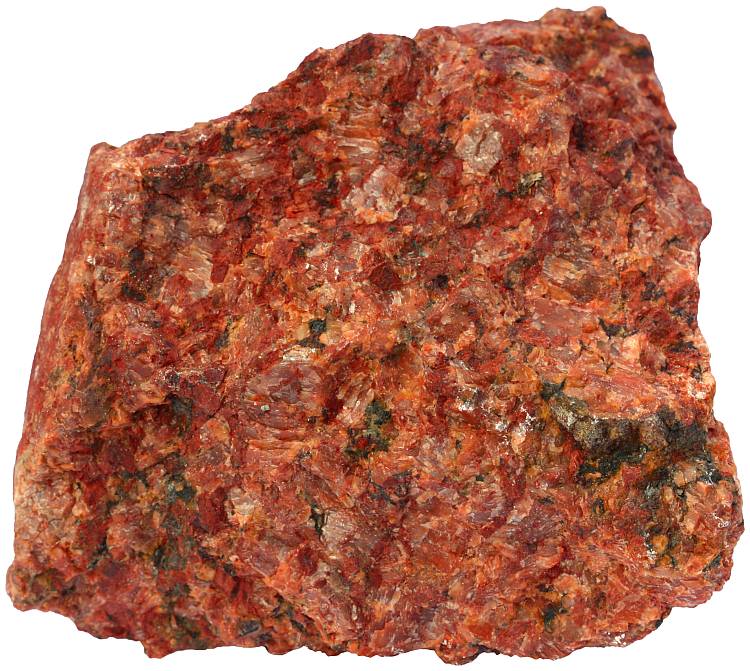Syenite is an igneous rock that solidified slowly in the crust in a similar manner to granite. A true syenite (sensu stricto) is also compositionally resembling granite. The most notable difference is the absence or very low quantity of quartz while it is an essential component of granite. The dominant mineral is alkali feldspar, usually orthoclase. This rock type is found in a wide variety of colors.

The classification on the QAPF diagram. Different syenitic rock types cover large part of the diagram. The true syenites are rocks that fit into the area annotated in red. Syenitic rocks are mostly composed of alkali feldspar (A) with minor amounts of quartz (Q). Plagioclase feldspar (P) is clearly less important than alkali deldspar. Foid syenites contain significant amount of relatively rare silicate minerals known as feldspathoids (F) which are called foids for simplicity. Note that Q and F are mutually exclusive. Syenitic rock that contains quartz can not contain feldspathoids and vice versa — foid-bearing and foid syenites contain no quartz.
The term “syenite” in a wider sense involves similar rock types like quartz syen., alkali feldspar syenite, foid syen., foid monzosyenite, etc. The classification principles are shown on the diagram below.
The diagram above may leave us an impression that the true syenite is a relatively insignificant part of the whole family. Actually, this is not true. Syenite sensu stricto and quartz syenites as well are the most common of the whole group, although syenite is a relatively rare rock type anyway, especially when compared with granite or other granitoids. Rocks like nepheline or sodalite syenites are actually curiosities that please the eye of a geologist, but are by no means common rocks we are likely to see all around us.
Alkali feldspar forming the majority of most syenitic rocks is usually intergrown with sodium-rich plagioclase feldspar (usually oligoclase). Such feldspar intergrowth is named perthite and this is the reason why syenite is more common rock type than alkali feldspar syen. which contains almost no plagioclase. Plagioclase may appear in syenitic rocks in addition to perthitic alkali feldspar also as a separate phase. Dark mica biotite and amphibole hornblende are usual mafic constituents. Alkali syenites may contain somewhat unusual minerals like aegirine, arfvedsonite, etc. Common accessory minerals are zircon, apatite, sphene, magnetite, and ilmenite.
The approximate extrusive (volcanic) equivalent of syenite (more precisely alkali syen. which is rich in sodium) is trachyte. Phonolite is an approximate equivalent of foid syenite. I said “approximate” because the classification principles used to classify plutonic and volcanic rocks are in most cases different. While the classification of plutonic rocks is based on mineralogical composition, the same approach is not practical with fine-grained or even partially glassy volcanic rocks. They are classified according to their chemistry and the results are plotted on the TAS diagram.
Syenitic rocks are usually associated with other plutonic rocks. They form relatively small intrusive bodies or parts of larger intrusions. Most syenitic seem to be associated with extensional tectonic regime (rifting continents). At least some of them are believed to be fractionation products of alkali-rich basaltic magmas, but there are several different mechanisms responsible for the genesis of a syenitic magma. In this sense it is again similar to granite which is also defined solely by its mineralogical composition although there are very different possible ways how granitic magma can evolve. It is perhaps inevitable because minerals are something we can determine, unlike genesis which in many cases is still a mystery.
An immense number of terms describing many varieties have been used in the past: foyaite, canadite, durbachite, umptekite, nordmarkite (quartz syen.) and perthosite (alkali feldspar syen.) are perhaps the best known unofficial names of syenite varieties. Shonkinite is a dark-colored variety of foid syenite which generally contains more pyroxene than alkali feldspar. Larvikite is a famous decorative stone from Norway. It exhibits a characteristic schiller, but larvikite contains more plagioclase than alkali feldspar and is therefore monzonite. Many so-called syenites are actually monzonites. For some reason the term “monzonite” seem to be little known and rarely used.
The term “syenite” is actually an ancient one. There is a town named Syene (nowadays: Aswan) in Egypt. However, the rocks near that town after which this rock got its name are actually hornblende-bearing granites according to modern classification principles.

Quartz alkali feldspar syenite from Estonia. Width of sample 8 cm.

A sample from Lilla Söderby, Sweden. Width of sample 10 cm.

Alkali feldspar syenite (also known as umptekite) from Sweden. Width of sample 12 cm.

Nepheline monzosyenite from Sweden consisting of albite, nepheline, and mafic minerals. Such rocks rich in sodium feldspar albite are sometimes referred to as canadite. Width of sample 17 cm.
Granite is an extremely beautiful stone which has made its revival in regarding new houses today and also the remodeling of older houses. The traditional Egyptians saw the good thing about granite and tried on the extender within their houses as flooring. Additionally they tried on the extender to construct the ultimate resting places of the important leaders and individuals of means (the pyramids).